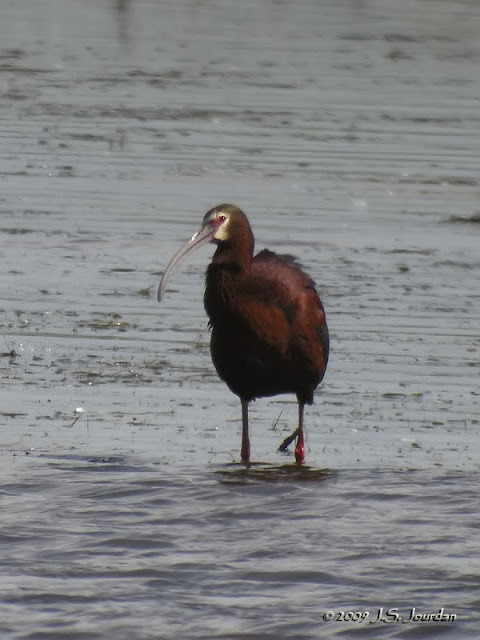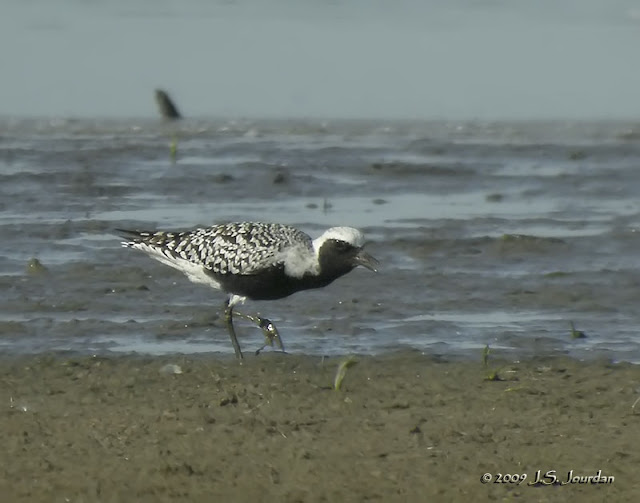White-faced Ibis @ Pt. Mouillee - 30 May 2009
I arrived at Mouillee Creek at 7 am and biked my way up the Middle Causeway toward the Walpatich and Lautenschager Units. Several Marsh Wrens were making a fuss in the cattails in the Walpatich Unit so I attempted a few digiscoped images as they popped into the open. At 70-80 feet it was a bit far for good digiscoping, but I managed a couple of decent keepers.
I had better luck just up the road near the pumphouse. A Willow Flycatcher was perched atop a Willow and singing its "Fitz-bew" song. I was able to set up within 2o feet of the bird and capture several nice images in the morning sun.
Continuing on, I scoped the Lautenschager Unit and found only a few Northern Shovelers. An angry Red-winged Blackbird scolded me from the ground (and in the air) as I approached its nest that was hidden somewhere nearby.
Will Weber had found a pair of Red Knots earlier in the morning from this area, but they must've moved on before I got there.
As I rode past the Long Pond Unit toward the Vermet Unit I spotted a small flock of 8 Semipalmated Plovers and a (presumed) White-faced Ibis feeding among several Great Egrets. One, possibly two birds had been reported within the last week and I suspected I was seeing one of the same birds. As I walked back along the 'new' dike next to the south side of the unit I met up with Will, who was already scoping and digiscoping the bird. My attempts at digiscoping the bird, which was at least 50 yds away, were less than successful. We did enjoy nice views of the white face, red lores, and red eyes that distinguish it from the look-alike Glossy Ibis.
Cell 3 was bustling with mostly Dunlin and Semipalmated Sandpipers, but we did see several Black-bellied Plovers close by. A pair of Lesser Yellowlegs were also nearby. I attempted to digiscope a nice breeding-plumaged BBP but grasses along the shoreline obscured a clean view of the bird. I ultimately flushed the bird as I followed it along the dike.
I was now running short on time, so I took my leave of Will and headed back toward the car. As I reached the west ends of the Vermet and Lead Units a flock of two-dozen Black Terns were noisily feeding near the dike and challenged me to a shooting match (which they won). I had trouble focusing the Nikon D300 and Sigma 400mm/f-5.6 on the birds as they whistled by, and could only get silhouette shots against the now-backlit skies. Fly-by Forster's Terns were less trouble and more obliging targets.
As I passed the Long Pond Unit I noticed that the White-faced Ibis was now about half its original distance, so I tried digiscoping the bird again. This time, despite now-driving winds, I managed several nice shots of the bird as it fed alone in the shallow marsh. Best shots occurred when the bird turned its head to show its red eyes and red face-patches. Apparently I managed to photograph it before it flew, since Will was unable to find it an hour later when he returned this way.
Pte. Mouillee SGA (permit required Sep 1-Dec 15), Monroe, Michigan, US
May 30, 2009 7:00 AM - 10:00 AM
Protocol: Traveling
5.0 mile(s)
Checklist Comments: Will Weber here, as well.
22 species
Blue-winged Teal (Spatula discors) 1
Northern Shoveler (Spatula clypeata) 2
Gadwall (Mareca strepera) 1
American Wigeon (Mareca americana) 1
Green-winged Teal (Anas crecca) 1
Canvasback (Aythya valisineria) 2
Redhead (Aythya americana) 1
Lesser Scaup (Aythya affinis) 1
Ruddy Duck (Oxyura jamaicensis) 1
Pied-billed Grebe (Podilymbus podiceps) 2
Common Gallinule (Gallinula galeata) 1
Black-bellied Plover (Pluvialis squatarola) 3
Semipalmated Plover (Charadrius semipalmatus) 8 Vermet
Lesser Yellowlegs (Tringa flavipes) 2
Dunlin (Calidris alpina) 12
Semipalmated Sandpiper (Calidris pusilla) 12
Black Tern (Chlidonias niger) 24 As I reached the west ends of the Vermet and Lead Units a flock of two-dozen Black Terns were noisily feeding near the dike and challenged me to a shooting match (which they won). I had trouble focusing the Nikon D300 and Sigma 400mm/f-5.6 on the birds as they whistled by, and could only get silhouette shots against the now-backlit skies.
White-faced Ibis (Plegadis chihi) 1 feeding among several Great Egrets
Osprey (Pandion haliaetus) 2
Willow Flycatcher (Empidonax traillii) 1
Marsh Wren (Cistothorus palustris) 2
Red-winged Blackbird (Agelaius phoeniceus) 1
View this checklist online at https://ebird.org/checklist/S4
This report was generated automatically by eBird v3 (https://ebird.org/home)
May 30, 2009 7:00 AM - 10:00 AM
Protocol: Traveling
5.0 mile(s)
Checklist Comments: Will Weber here, as well.
22 species
Blue-winged Teal (Spatula discors) 1
Northern Shoveler (Spatula clypeata) 2
Gadwall (Mareca strepera) 1
American Wigeon (Mareca americana) 1
Green-winged Teal (Anas crecca) 1
Canvasback (Aythya valisineria) 2
Redhead (Aythya americana) 1
Lesser Scaup (Aythya affinis) 1
Ruddy Duck (Oxyura jamaicensis) 1
Pied-billed Grebe (Podilymbus podiceps) 2
Common Gallinule (Gallinula galeata) 1
Black-bellied Plover (Pluvialis squatarola) 3
Semipalmated Plover (Charadrius semipalmatus) 8 Vermet
Lesser Yellowlegs (Tringa flavipes) 2
Dunlin (Calidris alpina) 12
Semipalmated Sandpiper (Calidris pusilla) 12
Black Tern (Chlidonias niger) 24 As I reached the west ends of the Vermet and Lead Units a flock of two-dozen Black Terns were noisily feeding near the dike and challenged me to a shooting match (which they won). I had trouble focusing the Nikon D300 and Sigma 400mm/f-5.6 on the birds as they whistled by, and could only get silhouette shots against the now-backlit skies.
White-faced Ibis (Plegadis chihi) 1 feeding among several Great Egrets
Osprey (Pandion haliaetus) 2
Willow Flycatcher (Empidonax traillii) 1
Marsh Wren (Cistothorus palustris) 2
Red-winged Blackbird (Agelaius phoeniceus) 1
View this checklist online at https://ebird.org/checklist/S4
This report was generated automatically by eBird v3 (https://ebird.org/home)



























Excellent sitings and photos! I just ordered the canon a590 for digiscoping..I am hoping it works well.
ReplyDeleteWonderful captures Jerry great Willow Flycatcher too its hard to get really close to this guy at times.
ReplyDelete